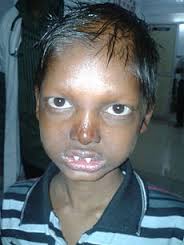Ectodermal dysplasia is a large group of inherited disorders characterised by a primary defect in hair, teeth, nails or sweat gland function, in addition to another abnormality in a tissue of ectodermal origin, e.g. .
The ectoderm is the outermost layer of cells in embryonic development and contributes to the formation of many parts of the body including all those described above. Ectodermal dysplasia occurs when the ectoderm of certain areas fails to develop normally. All ectodermal dysplasias are present from birth and are non-progressive.
Diagnosis: In some cases, ectodermal dysplasia is apparent at birth. In other cases, a parent or doctor may only begin to suspect that a problem exists when teeth fail to develop normally. The ectodermal dysplasias are diagnosed by the pattern of what part of the body is affected and how it has developed and functions. Specific genetics tests to diagnose ectodermal dysplasia are available for only a limited number of ectodermal dysplasias.
Causes: All ectodermal dysplasias are heritable. However, it is possible for a child to be the first person in his/her family to be affected by an ectodermal dysplasia. In that case, the condition likely has been caused by a change in the DNA or a genetic mutation.
Treatment: There are no cures for ectodermal dysplasias, but many treatments are available to address the symptoms. Research is ongoing to learn more about how different genes cause ectodermal dysplasias, what may be done to prevent the disorders in the future, and how to better treat individuals who are affected.
The affected derivatives of ectoderm
Teeth
Teeth may be missing, pointed, widely spaced, or prone to cavities because of defective enamel. Dental treatment is necessary and children may need dentures as early as two years of age. Multiple denture replacements are needed as the child grows, and dental implants may be an option in adolescence. Orthodontic treatment may also be necessary.
Hair
Scalp and body hair may be absent, sparse, thin, very light in color, excessively brittle, curly, or even twisted. Wigs can mask defects in hair development.
Nails
Fingernails and toenails may be thick or thin, abnormally shaped, discolored, ridged, slow-growing, or brittle. The cuticles may be prone to infections.
Sweat Glands
Many individuals affected by ectodermal dysplasia cannot perspire. Their sweat glands may function abnormally or may not have developed at all. Without normal sweat production, the body cannot regulate temperature properly. Therefore, overheating is a common problem, especially during hot weather. Access to cool environments is important.
Skin
Skin may be thin and pale, dry, scaly and easily irritated, prone to rashes, infections and sunburn, or thick over the palms and sole. Skin erosions or open areas of the skin on the scalp, hands and feet are possible. Care must be taken to prevent cracking, bleeding, and infection.

